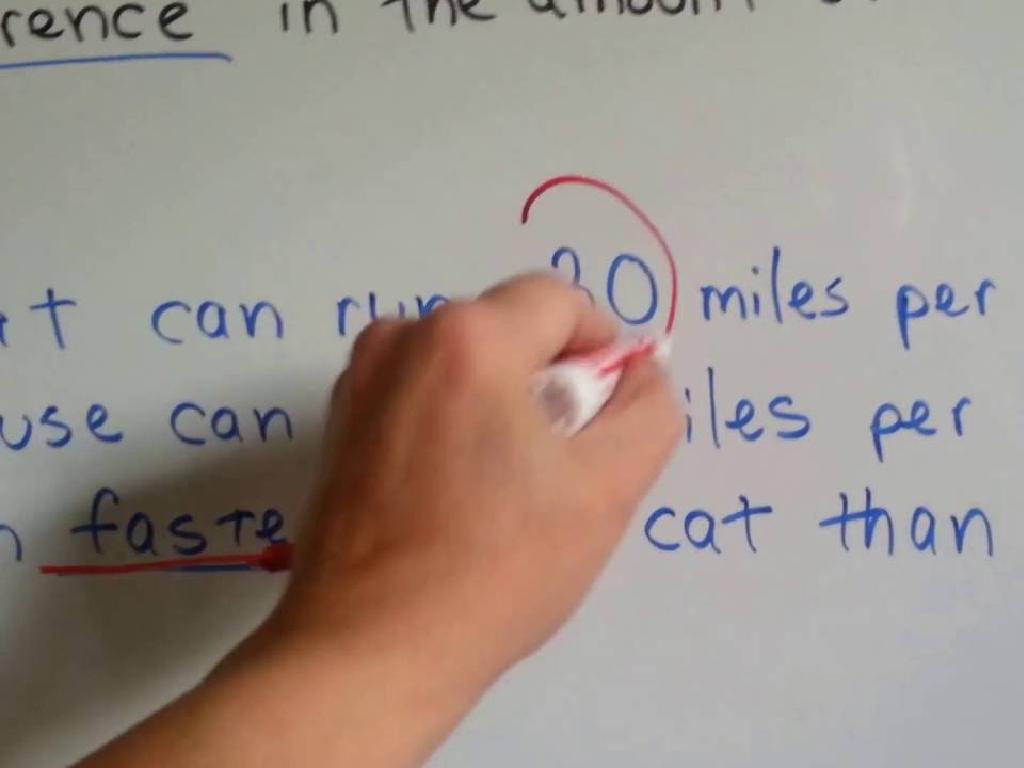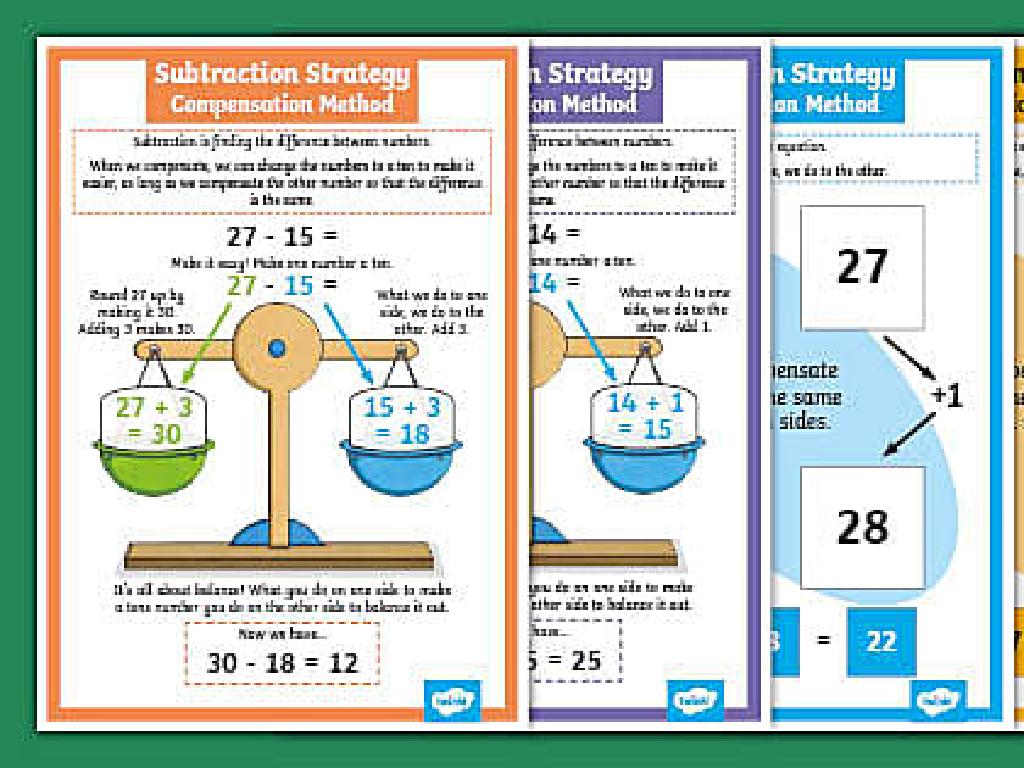Seed Disperser: Common Ostrich
Subject: Science
Grade: First grade
Topic: Animals
Please LOG IN to download the presentation. Access is available to registered users only.
View More Content
The Ostrich: Nature’s Gardener
– Ostriches are unique birds
– They are the largest birds and can’t fly
– What’s special about ostriches?
– Ostriches help plants grow
– They eat seeds and travel long distances
– They spread seeds around
– Seeds get dispersed when ostriches poop
|
This slide introduces first graders to the concept of seed dispersal by the common ostrich. Start by engaging the students with the unique characteristics of the ostrich, such as their size and inability to fly. Ask the children what they know about ostriches to make the session interactive. Explain how ostriches contribute to the environment by eating seeds and then dispersing them through their droppings, which helps plants grow in different areas. This is a fundamental concept in understanding ecosystems and the role animals play in them. Use simple language and encourage students to think of the ostrich as a ‘gardener’ who helps plants to spread and grow.
Meet the Ostrich: A Seed Disperser
– Ostriches are the biggest birds
– They have wings but can’t fly
– Their long legs help them run fast
– They can sprint up to 70 km/h!
– Ostriches spread seeds by eating them
– Seeds pass through them and grow elsewhere
|
Introduce the ostrich as the largest bird in the world, highlighting its unique characteristics such as its inability to fly despite having wings, and its remarkable speed due to its long legs. Emphasize the role of ostriches in seed dispersal, explaining how the seeds they eat are spread across the land when they move and digest them. This helps plants grow in new places. Encourage students to think about how different animals, including humans, can help plants grow by spreading seeds. You can use a story or a short video of an ostrich running to make the lesson engaging and memorable for the first graders.
How Ostriches Help Seeds Grow
– Seeds are baby plants
– Just like you, seeds start small and grow big!
– Seeds need soil, water, sun
– Think of seeds as tiny plant eggs that need the right spot to hatch.
– Ostriches are seed movers
– Ostriches eat seeds and walk far, taking seeds to new places.
– Seeds travel with ostriches
– When ostriches poop, they plant seeds!
|
This slide introduces first graders to the concept of seeds and their requirements for growth, as well as the role of animals, specifically ostriches, in seed dispersal. Explain that seeds are like the babies of plants and need the right conditions, such as soil, water, and sunlight, to grow into new plants. Discuss how animals like ostriches help in moving seeds by eating them and then traveling long distances before the seeds come out in their poop in a new location, which can be a good place for the seed to grow. This natural process helps plants spread to different areas. Encourage the children to think about how animals help plants and to share any experiences they may have with planting seeds or seeing animals in nature.
How Ostriches Help Plants Grow
– Ostriches eat lots of fruits
– They swallow seeds whole
– Seeds are not digested and stay safe inside
– Travel far and spread seeds
– Seeds come out in new places as ostriches poop
– Seeds grow into new plants
– Helps plants spread to new areas
|
This slide aims to teach first-grade students about the role of the common ostrich in seed dispersal. Explain that ostriches eat fruits and the seeds inside them. Since ostriches can travel long distances, when they poop, the seeds are deposited in new locations, far from where they were eaten. This is important because it helps plants to spread and grow in new areas, which is good for the environment. Use simple language and relatable concepts to help students understand how animals like ostriches contribute to the life cycle of plants.
Why Seed Dispersal is Important
– Helps plants grow in new areas
– Prevents plant overcrowding
– Creates more food and homes
– Like more berries for birds and burrows for rabbits!
– Helps our friend, the ostrich!
– Ostriches eat seeds and walk far away, then the seeds grow there!
|
This slide aims to explain the concept of seed dispersal to first graders, emphasizing its importance in nature. Seed dispersal allows plants to spread to new areas, which is essential for the survival and growth of various plant species. It also prevents too many plants from growing too close together, which can lead to competition for resources. Additionally, new plants provide food and shelter for a variety of animals, maintaining a balanced ecosystem. The common ostrich plays a role in this process by eating seeds and then traveling long distances before the seeds are deposited in a new location, ready to grow. Encourage the children to think about how animals, like the ostrich, help plants and other animals by spreading seeds.
Let’s Review: Ostriches Help Plants Grow!
– Ostriches are large, flightless birds
– They have long legs for running instead of flying
– They eat fruits and spread seeds
– When they poop, seeds come out in new places
– Seed dispersal is key for plant growth
– New plants can grow from these seeds far away
– Ostriches contribute to nature’s cycle
|
This slide is a review of how ostriches, despite being unable to fly, play a crucial role in their ecosystem by aiding in seed dispersal. Emphasize the size and speed of ostriches, and how their diet of fruits allows them to spread seeds over wide areas through their droppings. Explain that seed dispersal is vital for the spread of plants, which can lead to more diverse and healthy ecosystems. Encourage the students to think about how animals, even without knowing, can help plants grow and thrive, maintaining the balance of nature.
Seed Dispersal Game: Be an Ostrich!
– Pretend to be seed-dispersing ostriches
– Each student receives a ‘seed’
– ‘Plant’ seeds in our classroom ‘field’
– Observe how seeds spread out
|
This activity is designed to help first graders understand the role of animals like ostriches in seed dispersal. Each student will act as an ostrich and will be given a bean or a small pom-pom to represent a seed. They will then ‘plant’ this seed in a designated area of the classroom that represents the field. The goal is to show how seeds can be spread to different areas, ensuring the growth of new plants. For the activity, consider having different ‘habitats’ within the classroom where seeds can be planted, such as areas marked as ‘forest’, ‘grassland’, and ‘desert’. Encourage students to think about how seeds need to be spread to different places to grow. After the activity, discuss with the students how their actions mimicked what ostriches do in the wild.






